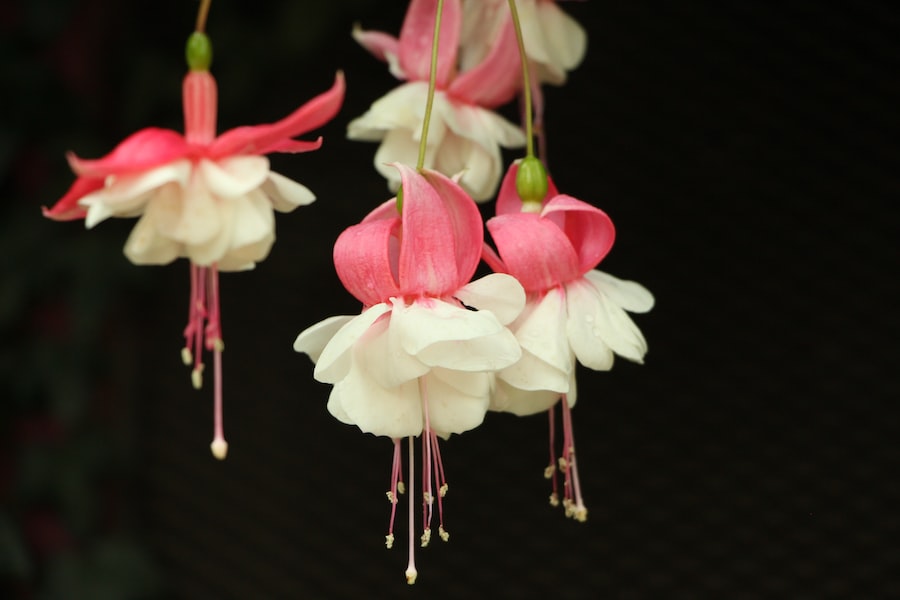Flower Power: A Guide to Eliminating Grass from Your Flower Beds

Maintaining a healthy and vibrant flower bed is a goal for many gardeners and homeowners. However, one common problem that can hinder the growth and beauty of flower beds is the presence of grass. Grass can be detrimental to flower beds for several reasons, including competition for nutrients and water, overgrowth and suffocation of flowers, and an unsightly appearance. In order to achieve a flourishing flower bed, it is important to eliminate grass and create an environment that is conducive to the growth of flowers.
Key Takeaways
- Eliminating grass from flower beds is important for their health and beauty.
- Grass can negatively impact flower beds by competing for nutrients and water.
- Choosing the right tools for grass removal is crucial for success.
- Preparing flower beds before grass elimination is necessary for optimal results.
- Manual, chemical, and natural methods can all be effective for removing grass from flower beds.
The Negative Impacts of Grass on Flower Beds
One of the main reasons why grass is harmful to flower beds is because it competes with flowers for essential resources such as nutrients and water. Grass has a strong root system that can quickly spread and take up valuable space in the soil, leaving less room for flowers to grow and thrive. This competition can result in stunted growth or even death of the flowers.
In addition to competing for resources, grass can also overgrow and suffocate flowers in the bed. Grass has a tendency to spread rapidly and can quickly cover and smother delicate flowers. This can lead to a decline in flower health and ultimately result in their demise.
Furthermore, the presence of grass in flower beds can detract from their overall appearance. Grass has a different texture and color compared to most flowers, which can create an unattractive contrast. This can make the flower bed look messy and unkempt, diminishing its aesthetic appeal.
Choosing the Right Tools for Removing Grass from Your Flower Beds
When it comes to eliminating grass from flower beds, there are several tools and methods that can be used. The choice of tool will depend on personal preference, the size of the flower bed, and the extent of the grass infestation.
Manual tools such as hand trowels or garden forks can be effective for small flower beds or for removing individual patches of grass. These tools allow for precise and targeted removal of grass without disturbing the surrounding flowers.
Chemical options, such as herbicides, can also be used to eliminate grass from flower beds. Herbicides work by killing the grass at its roots, preventing regrowth. It is important to choose a herbicide that is specifically formulated for use in flower beds and follow the instructions carefully to avoid damaging the flowers.
For those who prefer natural alternatives, there are several methods that can be used to eliminate grass from flower beds. Mulching involves covering the bed with a layer of organic material, such as wood chips or straw, which prevents grass from growing. Solarization is another natural method that involves covering the bed with a clear plastic sheet to trap heat and kill the grass. Smothering is yet another option, which involves covering the grass with a thick layer of newspaper or cardboard to block out sunlight and prevent growth.
Preparing Your Flower Beds for Grass Elimination
| Task | Time Required | Tools Needed |
|---|---|---|
| Remove existing plants and grass | 1-2 hours | Gloves, shovel, rake, weed trimmer |
| Loosen soil and remove debris | 2-3 hours | Garden fork, rake, wheelbarrow |
| Amend soil with compost or fertilizer | 1-2 hours | Compost, fertilizer, garden fork, rake |
| Level soil and create edges | 1-2 hours | Leveling tool, edging tool, string |
| Water soil thoroughly | 30 minutes | Watering can, hose |
Before embarking on the process of eliminating grass from your flower beds, it is important to properly prepare the area. This will ensure that the process is effective and that your flowers are not damaged in the process.
Firstly, clear the area of any debris or weeds that may be present. This will make it easier to identify and remove the grass. Use a rake or garden fork to loosen any compacted soil and remove any rocks or roots that may impede the removal process.
Next, prepare the soil by adding organic matter such as compost or well-rotted manure. This will improve soil fertility and provide essential nutrients for your flowers. It is also important to ensure that the soil is well-drained to prevent waterlogging, which can be detrimental to flower health.
Lastly, protect existing plants by carefully covering them with a tarp or plastic sheeting before beginning the grass elimination process. This will prevent any accidental damage to your flowers and ensure that they remain healthy throughout the process.
Manual Grass Removal Techniques for Flower Beds
Manual grass removal techniques can be effective for small flower beds or for removing individual patches of grass. These techniques require physical effort but can be precise and targeted, minimizing damage to surrounding flowers.
One method of manual grass removal is hand digging. This involves using a hand trowel or garden fork to carefully dig up the grass, ensuring that the roots are completely removed. It is important to be thorough and remove all traces of grass to prevent regrowth.
Another option is to use a sod cutter, which is a specialized tool designed for removing grass and its roots. A sod cutter works by slicing through the grass and lifting it out of the ground. This method is particularly useful for larger flower beds or for removing large areas of grass.
Tilling is another manual technique that can be used to remove grass from flower beds. This involves using a garden tiller or cultivator to break up the soil and expose the grass roots. Once the roots are exposed, they can be easily removed by hand or with a garden fork.
Chemical Grass Removal Methods for Flower Beds

Chemical grass removal methods can be effective for larger flower beds or for areas with a heavy infestation of grass. These methods involve the use of herbicides, which work by killing the grass at its roots and preventing regrowth.
There are two main types of herbicides that can be used in flower beds: pre-emergent herbicides and post-emergent herbicides. Pre-emergent herbicides are applied before the grass has a chance to germinate, preventing it from growing in the first place. Post-emergent herbicides, on the other hand, are applied after the grass has already emerged and are designed to kill existing plants.
When using herbicides, it is important to choose a product that is specifically formulated for use in flower beds and follow the instructions carefully. It is also important to take precautions to protect yourself and the environment, such as wearing protective clothing and avoiding application on windy days.
Natural Ways to Eliminate Grass from Flower Beds
For those who prefer natural alternatives, there are several methods that can be used to eliminate grass from flower beds. These methods are safe for the environment and do not require the use of chemicals.
One natural method is mulching. This involves covering the flower bed with a layer of organic material, such as wood chips or straw. The mulch acts as a barrier, preventing grass from growing and competing with your flowers for resources. Mulching also helps to retain moisture in the soil and suppresses weed growth.
Solarization is another natural method that can be used to eliminate grass from flower beds. This method involves covering the bed with a clear plastic sheet, which traps heat and kills the grass. The plastic should be left in place for several weeks to ensure that all the grass is killed.
Smothering is yet another natural option for eliminating grass from flower beds. This method involves covering the grass with a thick layer of newspaper or cardboard, which blocks out sunlight and prevents growth. The newspaper or cardboard should be weighed down with rocks or bricks to keep it in place.
Maintaining Grass-Free Flower Beds
Once you have successfully eliminated grass from your flower beds, it is important to maintain them to ensure that they remain free of grass and continue to thrive.
Regular maintenance is key to keeping your flower beds healthy and free of grass. This includes regular weeding to remove any new grass or weeds that may emerge. It is important to be vigilant and remove any new growth as soon as it appears to prevent it from spreading.
Preventing regrowth is also important in maintaining grass-free flower beds. This can be achieved by regularly applying mulch or using a weed barrier to prevent grass seeds from germinating. It is also important to avoid introducing grass seeds or sod into the flower bed, as this can lead to new grass growth.
Fertilizing and watering your flower beds regularly will also help to keep them healthy and free of grass. Flowers require nutrients and water to thrive, so it is important to provide them with the necessary resources. Use a balanced fertilizer and water deeply and infrequently to encourage deep root growth and discourage shallow grass roots.
Benefits of a Grass-Free Flower Bed
Maintaining a grass-free flower bed offers several benefits, both for the health of your flowers and for your overall gardening experience.
One of the main benefits of a grass-free flower bed is improved flower growth. By eliminating grass, you are removing a major competitor for resources such as nutrients and water. This allows your flowers to receive the full benefit of these resources, resulting in healthier and more vibrant blooms.
Another benefit of a grass-free flower bed is reduced maintenance. Grass requires regular mowing and trimming, which can be time-consuming and labor-intensive. By eliminating grass, you are reducing the amount of maintenance required for your flower bed, allowing you to spend more time enjoying your garden.
In addition to improved flower growth and reduced maintenance, a grass-free flower bed also offers enhanced aesthetic appeal. Without the presence of grass, your flower bed will have a clean and well-maintained appearance. This can make your garden more visually appealing and create a welcoming and inviting space.
Enjoying a Beautiful and Healthy Flower Bed Without Grass
In conclusion, eliminating grass from your flower beds is an important step in maintaining a healthy and vibrant garden. Grass can be detrimental to flower beds due to its competition for resources, overgrowth and suffocation of flowers, and unsightly appearance. By choosing the right tools and methods for removing grass, preparing your flower beds properly, and maintaining them regularly, you can enjoy a beautiful and healthy flower bed without the presence of grass. So take action today and start creating the flower bed of your dreams!



